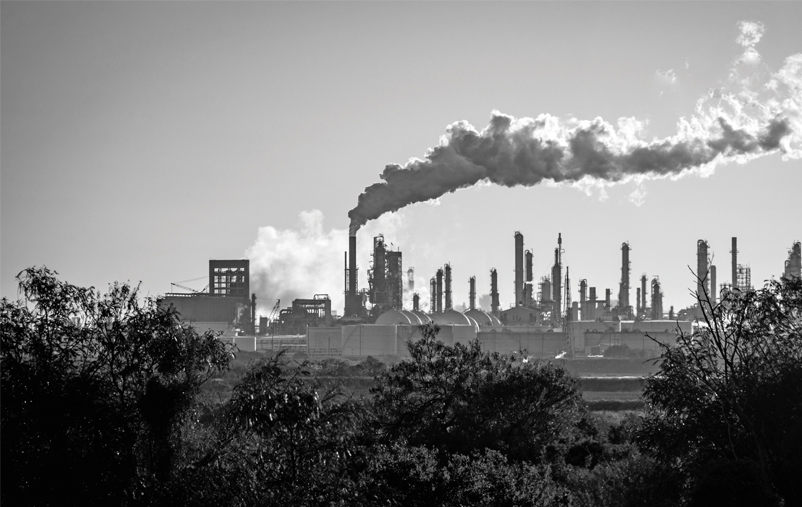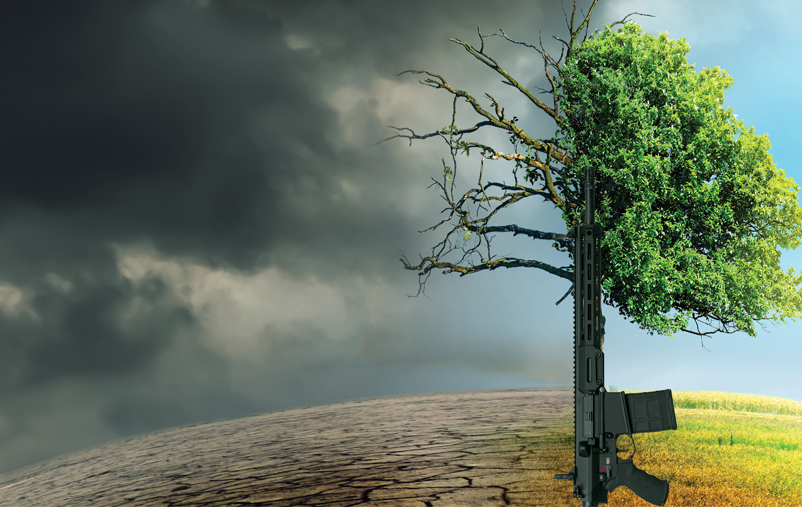The twenty-first century is one of the most important periods of change, during which the pace of climate change intensifies, which called for the best armies in the world to face the future challenge of climate change and form a concept of the war by developing military strategies to confront these changes, and anticipating their impact on their armed forces.
In light of this, climate change has become a slow-moving version of the “Covid 19” epidemic, which is what the great armies take into consideration in the future, and it will be addressed in the following axes of this study:
Most estimates suggest that violent and armed conflicts will increase in the twenty-first century, and that many of these conflicts will arise as a result of several factors, most notably climate change. There are previous studies that indicate that the causes of the outbreak of the so-called “Arab Spring” revolutions were related to climate, due to the rise in food prices and so on. It is therefore not difficult to see that climate change will exacerbate and fuel social unrest and may develop into violent conflict.
Therefore, climate change has undoubtedly become a multiplier factor for the threat of conflict, and in light of the link between armed conflict and climate change, statistical data indicated an increase of 10 to 20% in terms of the risk of armed conflicts associated with each half-degree increase in local temperatures. This is a conservative estimate. Moreover, there is broad consensus by researchers about the impact of climate change on increasing food insecurity, water scarcity, competition for resources, disruption of livelihoods, and stimulating migration or so-called “environmental refugees”, all of which can play a major role in the formation of bloody conflicts.
There are already studies that have demonstrated that climate has affected between 3% and 20% of the risks of armed conflict over the past century and that the impact is likely to increase significantly in the twenty-first century. According to environmentalists, estimating the role of climate change and its security impacts is important not only to understand the social costs of our continuing emissions of global warming, but also to prioritize responses, which has prompted major armies to consider the possibility of future conflicts and to make informed decisions about how they should mitigate the severity of climate change on future battlefields. Researchers at Princeton University and the University of California at Berkeley found that an average annual temperature increases of 1 degree Celsius (1.8 degrees Fahrenheit) led to a 4.5% increase in the Civil War that year.
Is climate change causing more wars?
In light of the escalation of the climate crisis, a question arises: What will the future battlefield look like, given the wars of the twentieth century that took place for land, religion and the economy reasons, while researchers expect that wars of the twenty-first century will be fought on something completely different: climate change, and the resulting water and food shortages. They concluded that when the conditions for survival of groups of people are threatened, the probability of violent conflict remains high, and this is a very basic principle.
Here it should be noted that global warming will not benefit the Middle East in any way, as there is ample evidence that the region will be most affected by climate change. Experts predict that due to global warming, the Tigris and Euphrates rivers will “disappear this century”, making conflict even more alluring if contested political control returns to the Fertile Crescent.
With global warming accelerating the pace of conflicts leading to hostilities, it is noteworthy that about half of the 25 countries most vulnerable to the crisis are also in military conflict. In a forward-looking vision towards the future, we find that Afghanistan has embodied a new type of international crisis, as temperatures have doubled in some areas more than the global average, and spring rains have diminished in an alarming way in the most important agricultural region of the country. The climate crisis is exacerbating disputes over water, forcing residents to leave their homes. The drought that hit Afghanistan in 2018 forced four million people to rely on food aid.

The impact of climate change on super power armies
In light of the dangers of climate change on the security of super powers, the Russian Security Council, in discussing how changes in the Earth’s climate directly affect Russia’s security and its relations with its neighbors, concluded that at the domestic level, Russia is more vulnerable than most countries; given the size of Russia’s permafrost region (roughly 66 percent of the country’s area), the melting now taking place threatens to undermine the foundations of entire cities, literally. In the words of one expert, a quarter of homes built in Tiksi, Yakutsk, Vorkuta, and other population centers will be completely uninhabitable.
Climate change and its consequences have become a major public concern and political issue in many countries. In some countries this also includes national security actors, particularly the armed forces in particular, in the United States and the United Kingdom, climate change policies are a major issue for the military.
While knowledge of the impact of climate change on the role of armed forces, military operations and facilities is scarce, in the current decade moves towards planning for a future characterized by climate change have begun. Moreover, some measures have already been taken, particularly with regard to mitigation efforts in these two countries. In both countries, for example, specific targets for reducing greenhouse gases have been set for most military activities.
There are still obvious differences. In the United States, the Army, and specifically the Navy, pioneered the adoption of climate change policies. Both former and active US Navy commanders were early advocates of taking climate change seriously, at a time when official US policy was still skeptical about the reality of climate change. The US Navy’s leadership role appears to have more to do with public concerns about the direction of US policy on climate change than with the Navy’s immediate interests. However, it is also present, for example regarding the possibility of needing better protection or even relocation of naval bases. Compared to the US Navy, the move of other branches of the US armed forces has been delayed. Furthermore, they have somewhat different priorities, with the Air Force and the Army’s primary focus on reducing energy consumption and energy security, with greenhouse gas reductions as a welcome side effect. In the United Kingdom, the relationship between climate change and energy policies is less robust than in the United States. Instead, the British military has adopted a detailed and specific agenda on climate change. It includes, in addition to mitigation efforts, studies of the future impacts of climate change and a general commitment to improving preparedness to meet these challenges.
It appears that both the Russian and Chinese militaries have paid little attention to the consequences of climate change for their future activities. However, there are clear differences again. In the Russian case, other urgent issues are given much higher priority over the agendas of national security actors. The first is the reconstruction, modernization and reform of the Russian armed forces. Moreover, climate change is not a good argument for those pushing for modernization because of so little attention to the consequences of climate change in Russia’s public and political discourse. However, this differs with respect to the Arctic, here there is great interest in Russia. For now, however, cooperative approaches are preferred in Russian Arctic politics. In contrast to the Russian case, in China, the military leadership appears to be well aware of the potential impacts of climate change on its role, operational demands, and facilities. However, public statements, and perhaps even internal discussions, are largely limited to tree planting and disaster relief. These operations, if one can also call them important, are important to the Chinese military, but what is most decisive in the Chinese debate are the limits set by the political leadership. A more active stance of the Chinese military on climate change issues would undermine the official Chinese position, which is that climate change is a development issue, not a security issue. While adaptation strategies and operations of armed forces are still in the study phase, even in the US and UK, analysis of the threat of climate change to facilities, particularly sea-level rise, is more urgent. The United States and the United Kingdom, and possibly China as well, are investigating this issue in detail.

The future strategies of the best armies in the world
At the beginning of the new decade, major armies began to attach great importance to the effects of climate change on their armed forces, as the climate change crisis was no longer a problem for future defense leaders, but an immediate challenge. Now, after years of avoiding the issue, the Biden administration requested 617 million dollars in fiscal year 2022 to prepare for, adapt and mitigate climate change.
In addition, Defense Secretary Lloyd Austin, having already identified climate change as a top priority, launched the Climate Working Group in response to an executive order in January signed by President Joe Biden. The strategy the US military is writing reveals a “highly detailed” action plan on climate change that outlines a multi-year effort on how the military will address climate issues. For its part, the Air Force, which is itself a major contributor to climate change, is looking for new ways to improve the combat capability of its fleet while reducing greenhouse gas emissions. The Army also studies energy supply and storage technologies, system-wide energy distribution powered by AI, the use of renewable energy sources for use in operational contexts, including forward and tactical operating bases, and the use of alternative fuel sources that increase operational endurance within the force while reducing carbon emissions. On top of that, the US military needs to generate battlefield power in challenging environments. The Army Corps of Engineers is also contributing to the department’s effort, having designed the Department of Defense Climate Assessment Tool, which predicts the effects of climate change at nearly 1,400 Department of Defense sites. In addition, unique approaches are being sought to develop building materials to reduce greenhouse gas emissions. As for the British Army’s military strategy to tackle climate change, in 2021 and beyond, the UK government decided to make tackling climate change its first international priority. In the defense context, it will take the lead in responding to emerging and conflict-related geopolitical threats exacerbated by climate change, as future environments require their armed forces to anticipate change in temperature extremes, increased flooding, and new, unfamiliar causes of conflict, i.e., the way in which that climate change will ultimately alter our world is complex and difficult to predict. In the first phase of the UK Army’s Military Strategy, the basics have been laid (2021-2025) where the Ministry of Defense will introduce a change step in projects already planned. The first phase will include working with suppliers to identify ways to reduce emissions of the equipment being used in the supply chain. A comprehensive database and baseline will be built to allow detailed plan decisions for all topics in the second and third phases, and broader sustainability will be pursued through annual defense plans. The second phase of Reducing and Adapting to the Future (2026-2035) will build on the successes of the first phase, in the following years, and the defense will look to significantly reduce emissions using current and emerging technology, and maximize opportunities to enhance the global response to the threat that climate change imposes on current and future operational capability and building more flexibility in real estate, supply chain and future equipment.
The third phase, Harnessing the Future (2036-2050), which will take place in the last fifteen years and in which the Ministry of Defense must do everything in its power to harness new technologies that increase flexibility and reduce emissions. The 3rd. phase will depend on efficiency, operational effectiveness, on innovation and foresight in previous phases in light of sustainable culture and behaviour.
As for the position of the Chinese army on the climate change crisis, there are some reports of an alternative to the use of fuel by the Chinese army, but it is not clear how intense or successful these efforts are. Military study groups also appear to be looking at the potential consequences of climate change for naval bases. In light of this, the Chinese military is still under pressure to improve energy efficiency to reduce greenhouse gas emissions.
Conclusion
Unsurprisingly, the United States, Russia, and China rank as the world’s most powerful militaries, respectively, in that order. In addition to the military might of these three countries, they also represent some of the countries with the highest greenhouse gas emissions. Therefore, as these countries suffer adverse effects from greenhouse gases, threats and their political perceptions will shape how they decide to act militarily. The militaries of the United States, Russia and China will each face unique challenges due to climate change, and thus will require unique responses in order to adapt. Besides influencing how military strategy is planned, there is also a debate among military strategists about how climate change will lead to an increase in armed conflict worldwide.
» By: Dr. Rania Fawzy (Israeli affairs researcher)













